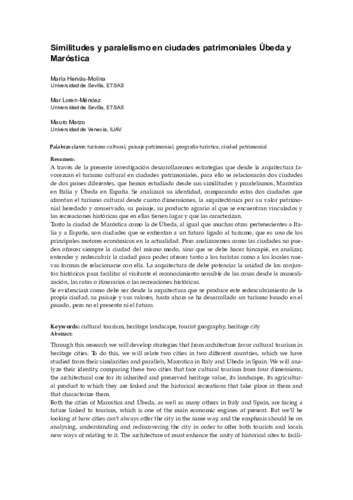Mostra el registre d'ítem simple
Similitudes y paralelismo en ciudades patrimoniales Úbeda y Maróstica
| dc.contributor.author | Hervás-Molina, María |
| dc.contributor.author | Loren-Méndez, Mar |
| dc.contributor.author | Marzo, Mauro |
| dc.coverage.spatial | east=11.655025746713775; north=45.744143437880425; name=Via 4 Novembre, 9, 36063 Marostica VI, Itàlia |
| dc.coverage.spatial | east=-3.3684447671841844; north=38.00856532420707; name=Plaza Ayuntamiento, 4, 23400 Úbeda, Jaén, Espanya |
| dc.date.accessioned | 2020-09-03T10:24:18Z |
| dc.date.available | 2020-09-27T00:36:15Z |
| dc.date.issued | 2020-09-28 |
| dc.identifier.citation | Hervás-Molina, M.; Loren-Méndez, M.; Marzo, M. Similitudes y paralelismo en ciudades patrimoniales Úbeda y Maróstica. A: Llop, C.; Cervera, M.; Peremiquel, F. (eds.). "IV Congreso ISUF-H: Metrópolis en recomposición: prospectivas proyectuales en el Siglo XXI: Forma urbis y territorios metropolitanos, Barcelona, 28-30 Septiembre 2020". Barcelona: DUOT, UPC, 2020, p. 1-18. ISBN 978-84-9880-841-4. |
| dc.identifier.isbn | 978-84-9880-841-4 |
| dc.identifier.uri | http://hdl.handle.net/2117/328337 |
| dc.description.abstract | A través de la presente investigación desarrollaremos estrategias que desde la arquitectura favorezcan el turismo cultural en ciudades patrimoniales, para ello se relacionarán dos ciudades de dos países diferentes, que hemos estudiado desde sus similitudes y paralelismos, Maróstica en Italia y Úbeda en España. Se analizará su identidad, comparando estas dos ciudades que afrontan el turismo cultural desde cuatro dimensiones, la arquitectónica por su valor patrimonial heredado y conservado, su paisaje, su producto agrario al que se encuentran vinculados y las recreaciones históricas que en ellas tienen lugar y que las caracterizan. Tanto la ciudad de Maróstica como la de Úbeda, al igual que muchas otras pertenecientes a Italia y a España, son ciudades que se enfrentan a un futuro ligado al turismo, que es uno de los principales motores económicos en la actualidad. Pero analizaremos como las ciudades no pueden ofrecer siempre la ciudad del mismo modo, sino que se debe hacer hincapié, en analizar, entender y redescubrir la ciudad para poder ofrecer tanto a los turistas como a los locales nuevas formas de relacionarse con ella. La arquitectura de debe potenciar la unidad de los conjuntos históricos para facilitar al visitante el reconocimiento sensible de las cosas desde la musealización, las rutas o itinerarios o las recreaciones históricas. Se evidenciará como debe ser desde la arquitectura que se produce este redescubrimiento de la propia ciudad, su paisaje y sus valores, hasta ahora se ha desarrollado un turismo basado en el pasado, pero no el presente ni el futuro. |
| dc.description.abstract | Through this research we will develop strategies that from architecture favor cultural tourism in heritage cities. To do this, we will relate two cities in two different countries, which we have studied from their similarities and parallels, Marostica in Italy and Ubeda in Spain. We will analyze their identity, comparing these two cities that face cultural tourism from four dimensions, the architectural one for its inherited and preserved heritage value, its landscape, its agricultural product to which they are linked and the historical recreations that take place in them and that characterize them. Both the cities of Marostica and Úbeda, as well as many others in Italy and Spain, are facing a future linked to tourism, which is one of the main economic engines at present. But we'll be looking at how cities can't always offer the city in the same way, and the emphasis should be on analysing, understanding and rediscovering the city in order to offer both tourists and locals new ways of relating to it. The architecture of must enhance the unity of historical sites to facilitate the visitor's sensitive recognition of things from the museum, routes or itineraries or historical recreations. It will be evident from the architecture that this rediscovery of the city itself, its landscape and its values is taking place. Up to now, tourism has developed based on the past, but not the present or the future. |
| dc.format.extent | 18 p. |
| dc.language.iso | spa |
| dc.publisher | DUOT, UPC |
| dc.relation.uri | http://hdl.handle.net/2117/330826 |
| dc.rights | Attribution-NonCommercial-NoDerivs 3.0 Spain |
| dc.rights.uri | http://creativecommons.org/licenses/by-nc-nd/3.0/es/ |
| dc.subject | Àrees temàtiques de la UPC::Urbanisme |
| dc.subject.lcsh | Tourist trade and city planning -- Italy -- Marostica |
| dc.subject.lcsh | Tourist trade and city planning -- Spain -- Ubeda (Jaén) |
| dc.subject.other | Turismo cultural |
| dc.subject.other | Paisaje patrimonial |
| dc.subject.other | Geografía turística |
| dc.subject.other | Ciudad patrimonial |
| dc.subject.other | Cultural tourism |
| dc.subject.other | Heritage landscape |
| dc.subject.other | Tourist geography |
| dc.subject.other | Heritage city |
| dc.title | Similitudes y paralelismo en ciudades patrimoniales Úbeda y Maróstica |
| dc.type | Conference report |
| dc.subject.lemac | Turisme i urbanisme -- Itàlia -- Marostica |
| dc.subject.lemac | Turisme i urbanisme -- Andalusia -- Úbeda |
| dc.rights.access | Open Access |
| local.citation.contributor | Llop, C.; Cervera, M.; Peremiquel, F. (eds.) |
| local.citation.pubplace | Barcelona |
| local.citation.publicationName | IV Congreso ISUF-H: Metrópolis en recomposición: prospectivas proyectuales en el Siglo XXI: Forma urbis y territorios metropolitanos, Barcelona, 28-30 Septiembre 2020 |
| local.citation.startingPage | 1 |
| local.citation.endingPage | 18 |


